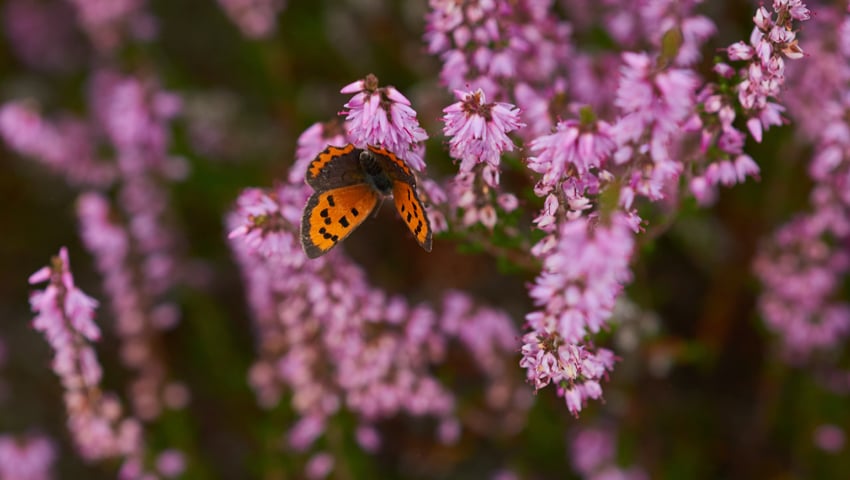Dunwich Heath, a rare heathland habitat cared for by the National Trust on the Suffolk coast is showing signs of recovery, with its patchwork of pink and purple heather back in bloom after being severely impacted by extreme heat and drought in 2022.
Part of the Suffolk Coasts and Heaths National Landscape, the site is nationally important for the rare and precious habitat that is home to special species including nightjar, woodlark and adders.
Three different types of heather typically grow and flower there from June to September – common, bell and cross-leaved – transforming the landscape into a bright and vibrant patchwork. But hotter, drier summers are pushing the limits of what the heather can cope with. Two years ago, a drought in the summer months coincided with the middle of the heather flowering season, the consequence of which was almost the entire heath failed to flower with some plants also dying.
Last summer, specialist drone surveys using infrared technology confirmed that there had been a 60 per cent loss in heather, with visible areas of die off and discoloration raising concerns about the wider impact on the habitat, which is the last large area of coastal heathland in the area.
Where there was significant die off in the heather, there was also a lower number of insects, particularly pollinators, which provide crucial food for nesting birds. Resident species such as the Dartford warbler depend on reliable food sources year-round, with numbers dropping from 30 breeding pairs to just under 20 from 2022 to 2023.
This year, however, there have been encouraging signs of recovery of the heather with a recent drone survey, conducted at the end of June, revealing that a further 11 per cent of heather has recovered. National Trust rangers believe that this is due to increased rainfall as February was the wettest on record in East Anglia.
Sam Cooper, National Trust Area Ranger at Dunwich Heath, said, “Results from the recent drone survey have confirmed that just over half of the heathland is now made up of live heather. This time last summer, it was down to 40 per cent, so it’s really encouraging.
“The wet start to the year has certainly helped, and we’ll be continuing to monitor how the weather impacts not just the heather itself, but the birds and other wildlife that depend on it.”
Every year, during the autumn and winter months, small areas of heather are cut to encourage new growth and this creates a mosaic of heather of different ages helping to produce a more diverse habitat for a range of wildlife.
Last year, Cooper and his conservation team, which is partly made up of volunteers, started the first of several trials to help establish the quickest method to restore the heather. Some areas of heather were left uncut to see if they would recover, other areas were cut and then scraped to encourage growth from seed, and some areas were just cut, with the cuttings removed.
Cooper said, “It’s still too early to see the full effect, but we’ve already observed some differences between our trials and we’ll use this to inform how we further manage the habitat.”
Ben McCarthy, Head of Nature Conservation & Restoration Ecology at the National Trust added, “As the UK’s largest conservation charity we are experiencing first-hand the consequences of more frequent extreme weather events, such as the prolonged period of drought that severely impacted the heath at Dunwich.
“Many rare wildlife and plant species rely on this and other habitats threatened by our changing climate, this is why one of our priority asks for the new government is to address this significant issue to help ensure generations for years to come can enjoy the nature, beauty and history of this country and sights such as carpets of purple heather are not lost.”
Richard Gilbert, Property Operations Manager at Dunwich Heath, said, “It’s great to see so much heather back in flower and looking the best it has in years.
“This time of year is always a favourite among our visitors, in part because Dunwich is the only place in the East of England where the heathland extends to the sea, so you get fantastic views and contrasts between the sky, sea and heath.”
